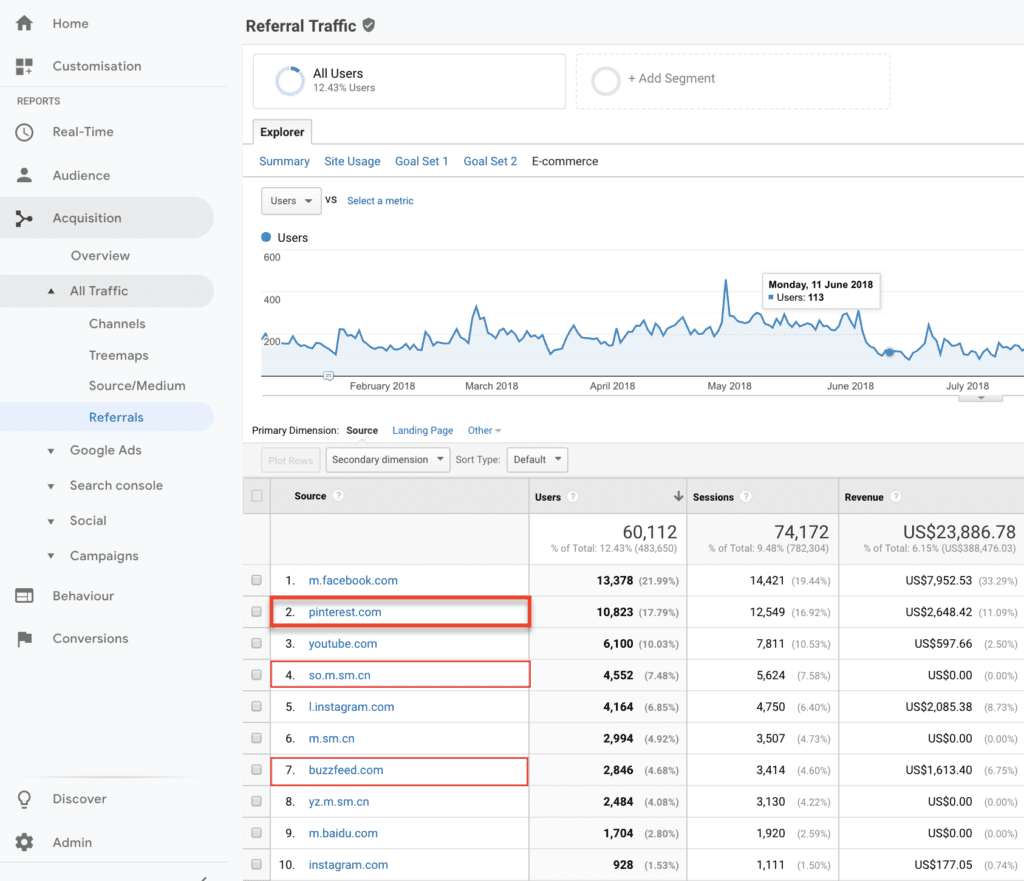
Are you tired of your website not getting enough visitors? Well, fret no more because I have the perfect solution for you! You can now buy referral traffic to boost your website’s visibility and increase your chances of success. Referral traffic is a game-changer when it comes to driving organic traffic to your site. With just a few clicks, you can get access to a wide network of websites that will refer visitors to your site. Imagine the possibilities! Your website will be flooded with eager visitors who are genuinely interested in what you have to offer. So why wait? Start boosting your referral traffic today and watch your website soar to new heights of success!
Contents
- 1 What Is Referral Traffic
- 2 Key Ways to Drive Referral Traffic to Your Website
- 3 Understanding the Benefits of Referral Traffic
- 4 How to Monitor Your Referral Traffic
- 5 Tips for Improving Referral Traffic to Your Site
- 6 How to See Referral Traffic in Google Analytics 4:
- 6.1 Pros and Cons Referral Website Traffic
- 6.2 FAQ for Referral Website Traffic:
- 6.2.1 What is referral traffic?
- 6.2.2 How is referral traffic different from other types of website traffic?
- 6.2.3 What are some examples of referral traffic sources?
- 6.2.4 How can I track and analyze referral traffic to my website?
- 6.2.5 What are some strategies for increasing referral traffic to my website?
What Is Referral Traffic
Referral traffic is when visitors come to a website through a direct link from another website. This kind of traffic can come from social media, online articles, blogs, and other sources outside of search engines.
For instance, when a user clicks on a link within a blog post to visit a website, that’s considered referral traffic.
Businesses can generate referral traffic by actively building links, posting as a guest on other websites, and using social media to share content.
One major benefit of referral traffic is that it can boost a website’s visibility and exposure. It can also help improve search engine ranking by influencing the quality and quantity of backlinks.
Moreover, it can increase website traffic and potentially attract new customers or clients.
Key Ways to Drive Referral Traffic to Your Website
Get Listed in Online Directories
Businesses can take several steps to increase their online visibility and drive referral traffic to their website. Starting with claiming their profiles on popular directories like Yelp, Yellow Pages, and Google My Business is a good first step. Providing accurate and complete information, including their website URL, improves their chances of being discovered by potential customers.
Encouraging customers to leave reviews and promptly responding to feedback on review websites can also boost visibility. Creating guest blog posts on industry-related websites is another effective way to reach a wider audience and establish expertise, ultimately driving more referral traffic to their own website.
Earn Mentions on Review Websites
Businesses can earn mentions on review websites and drive referral traffic to their website by providing exceptional products and customer service. Delighting customers increases the likelihood of positive reviews and mentions on review websites, which can increase website traffic. Encouraging satisfied customers to share their experiences on review websites and responding to both positive and negative reviews professionally can help build trust and drive referral traffic.
Benefits of earning mentions on review websites include improved online visibility, credibility, and the opportunity to showcase strengths and build a positive brand reputation.
Create and Share Guest Blog Posts
Creating and sharing guest blog posts is a great way to reach a wider audience.
It starts with finding relevant and reputable websites in the desired niche. By providing valuable content, guest bloggers can attract the interest of the target audience and encourage them to visit the author’s website through embedded links.
This can help to drive referral traffic, as readers who find the blog post interesting are more likely to click through to learn more.
To create successful guest blog posts, it’s important to conduct thorough research on the target audience and the website’s content guidelines.
Writing in a friendly and relatable tone can also engage readers. Including a clear call-to-action within the blog post can prompt readers to visit the website for more information or access additional resources.
Post and Engage on Social Media
Businesses can drive more people to their website using social media. They can do this by sharing interesting and relevant content on platforms like Facebook, Twitter, and Instagram.
They can share things like blog posts, videos, and product demos to get people talking and sharing. Replying to comments and interacting with followers can also help get more views and visitors.
One challenge is standing out in a busy online world. To do this, businesses can make unique and eye-catching content that people will want to share. It’s also important to stick to a regular posting schedule, which can be easier with scheduling tools.
Working with popular people or other brands can also help businesses attract more visitors to their website.
Understanding the Benefits of Referral Traffic
Increase in Leads
The increase in referral traffic has led to more leads for the website. Referral traffic brings in new potential customers and directs them to the site, generating a higher volume of leads. This increase is due to strategies like optimizing website content for sharing, engaging with influencers and industry experts, and participating in online communities and forums. These strategies not only increase leads but also improve their quality.
Various referral sources, like social media shares, backlinks from reputable websites, and mentions in industry-related publications and blogs, have contributed to the increase in leads. These sources effectively drive high-quality leads to the website, improving lead generation and customer acquisition overall.
Higher Quality Visitors
One effective way for a website to attract better visitors is by building relationships with industry influencers and reputable websites. This can be done by obtaining endorsements or backlinks from these sources. This can drive traffic from audiences genuinely interested in the content, resulting in more engaged visitors. Other strategies include guest posting on well-respected blogs, participating in industry forums, and forming partnerships with complementary businesses.
The benefits of attracting these types of visitors include increased brand credibility, higher conversion rates, and more opportunities for word-of-mouth referrals.
Additionally, these visitors are more likely to spend longer periods of time on the website, engaging with the content and contributing to a positive user experience.
Better Search Engine Rankings
To improve search engine rankings through referral traffic, businesses can focus on creating high-quality, shareable content. This content can encourage backlinks from reputable websites. It can be achieved through guest blogging, creating infographics, or participating in industry forums and discussions. This drives traffic to their website.
Businesses can also incorporate social media into their digital marketing strategy. Sharing content on platforms like Facebook, Twitter, and LinkedIn can reach a wider audience and attract more backlinks.
To effectively monitor and analyze their referral traffic, businesses can use web analytics tools like Google Analytics. These tools help track the sources of their website traffic. By identifying which websites and social media platforms generate the most referral traffic, businesses can strengthen those relationships and focus on creating more resonating content.
Some common challenges businesses face include identifying effective platforms for attracting quality backlinks, competing with other businesses for attention on those platforms, and staying updated on trends in content marketing and SEO. It requires a dedicated effort to consistently produce valuable and relevant content that will attract referral traffic and improve search engine rankings.
How to Monitor Your Referral Traffic
To monitor referral traffic to a website, you can use tools like Google Analytics, SEMrush, and Ahrefs. These tools give insights into where the traffic comes from, visitor behavior, and the performance of referral links.
You can differentiate referral traffic from other types by checking the traffic sources report in Google Analytics. This report shows the percentage of traffic from referrals compared to organic search or direct traffic.
When monitoring referral traffic, important metrics to look at are the number of referral visits, bounce rate, and conversion rate. These metrics help understand the quality of referral traffic and its impact on the website’s performance.
By regularly tracking and analyzing referral traffic with the right tools, website owners and marketers can make informed decisions to optimize their referral sources and improve their website’s performance.
Tips for Improving Referral Traffic to Your Site
Leave Comments on Blogs
Leaving comments on blogs can help drive traffic to a website. By sharing valuable insights or resources, readers may click on the commenter’s website link for more information. Engaging in conversation can make the website more visible to the blog’s audience, potentially increasing referrals. To maximize traffic, ensure comments are relevant and add value. Using a genuine tone and avoiding promotional language is important.
Consistently leaving thoughtful comments on relevant blogs can establish authority in the field, making the website enticing for readers to visit.
Participate in Industry Forums
Participating in industry forums can benefit businesses by driving referral traffic to their website. By engaging in discussions and providing valuable insights, businesses can attract potential customers.
For example, a fitness equipment company can participate in health and wellness forums to establish expertise and attract interested users. Engaging in forums involves participating in discussions, offering helpful advice, and avoiding overly promotional content. This can build credibility and trust, ultimately leading to increased referral traffic. However, businesses may face challenges like competition from other forum members and the need to consistently provide valuable content. Overcoming these challenges through strategic participation and maintaining a genuine presence in industry forums is essential for driving referral traffic effectively.
Design and Distribute Infographics
Businesses can create and share infographics to get more people to visit their website. They can do this by making infographics that are easy to understand and look nice, and by sharing them on social media. Using the company logo and website info on the info-graphic can also help bring people to the website. Some tips for getting more people to visit through infographics are knowing the target audience, making content they like, and using popular trends.
But there are challenges, like making good content, finding the right places to share it, and seeing how well it works.
Common Challenges with Referral Traffic
Businesses often struggle to drive referral traffic to their website. This is because it’s hard to get noticed among the vast online information and stand out in a crowded market.
Changes in algorithms or policies of referral sources can greatly impact traffic strategies. This means businesses must adapt to these changes to maintain a steady flow of incoming traffic.
Tracking and analyzing the success of referral traffic efforts can also be challenging. Businesses must use various tools and platforms to gather accurate data, interpret it, and improve their strategies.How to Buy Referral Traffic for Your Site Really Works
Additionally, accurately attributing the source of referral traffic can be difficult, making it hard to assess where efforts are most successful.
These challenges highlight the importance for businesses to continuously monitor, adjust, and optimize their referral traffic strategies to achieve the desired results.
Examples of Successful Referral Traffic Strategies
Businesses use various referral traffic strategies to boost website visits. They list their websites on online directories and review sites. Also, they create interesting guest blog posts on related industry blogs to attract new visitors. Social media platforms are also used to share engaging content and interact with the audience. This encourages people to visit their websites.
Businesses monitor and improve referral traffic using tools like Google Analytics. This helps them track where their traffic comes from and find areas for improvement. Analyzing this data helps them adjust their strategies.
For example, they might shift resources to the most effective channels or improve their website for a better user experience. These strategies have successfully increased referral traffic for many businesses.
Wrapping up
Referral traffic means visitors coming to your website from other websites. It’s an important part of website traffic and can bring in new visitors and potential customers.
Understanding how referral traffic works and how to track and optimize it is crucial for website owners and marketers.
How to See Referral Traffic in Google Analytics 4:

- Access Your GA4 Property:
- Log in to your Google Analytics account and select the GA4 property for the website you want to analyze.
- Navigate to the Reports:
- In the left sidebar, click on “Reports” to access the reporting interface.
- Explore the Acquisition Report:
- In the left sidebar, navigate to “Acquisition” to find reports related to how users are acquiring traffic.
- Access the Traffic Source/Medium Report:
- Within the “Acquisition” section, look for the “Traffic acquisition” report or a similar option. This report typically provides insights into various traffic sources.
- Select Referral as a Source/Medium:
- Look for the specific report that shows traffic sources, and within that, select “Referral” as the source or medium.
- Analyze Referral Traffic Data:
- Explore the data presented in the report. You should be able to see information about the websites that are referring traffic to your site.
- Use Secondary Dimensions:
- To gain more insights, you can use secondary dimensions like “Source/Medium,” “Landing Page,” or others, depending on your specific analysis needs.
- Apply Filters if Necessary:
- Use filters to refine the data if you want to focus on specific referral sources, landing pages, or other criteria.
- Set Date Range:
- Adjust the date range at the top right corner of the page to analyze referral traffic for a specific time period.
- Explore Real-time Data:
- For a more immediate view, you can also explore the “Real-time” reports to see live data, including referral traffic.
Pros and Cons Referral Website Traffic
- Dependency on external sources: Referral traffic relies on other websites referring visitors to your site. This means that if these referral sources decrease or stop sending traffic, your website’s traffic levels can be significantly impacted. It is important to diversify your traffic sources to mitigate this risk.
- Quality of traffic may vary: Not all referral traffic is created equal. While some referrals may be highly targeted and relevant to your website’s niche, others may not be. This can result in lower engagement and conversion rates for certain referral sources, making it essential to regularly analyze the quality of referral traffic.
- Difficulty in tracking conversions: Unlike direct or organic traffic, tracking conversions from referral traffic can be challenging. It may be difficult to attribute specific actions or purchases to referral sources accurately. This makes it harder to measure the return on investment (ROI) of referral campaigns or partnerships.
FAQ for Referral Website Traffic:
What is referral traffic?
- Referral traffic is when visitors come to your website from a direct link on another website. Examples include clicking on a link from a blog post, social media platform, or online article.
How is referral traffic different from other types of website traffic?
- Referral traffic comes from other websites linking to yours, while other types of traffic come from direct visits, search engines, or social media. For example, a blog post mentioning your website can generate referral traffic, while a direct visit comes from someone typing your URL into their browser.
What are some examples of referral traffic sources?
- Some examples of referral traffic sources are social media platforms like Facebook, Twitter, and Instagram, as well as other websites, blogs, and online forums that link to your website.
How can I track and analyze referral traffic to my website?
- You can track and analyze referral traffic to your website using Google Analytics. Go to the Acquisition > All Traffic > Referrals report to see which websites are sending traffic to your site. You can also set up UTM parameters in your referral links for more detailed tracking.
What are some strategies for increasing referral traffic to my website?
- Some strategies for increasing referral traffic to your website include creating high-quality content that others will want to link to, guest posting on other websites, and engaging with influencers in your industry to promote your website.






